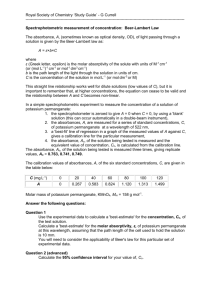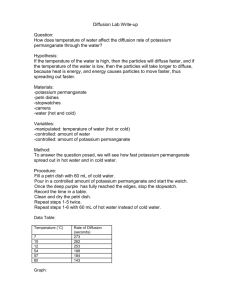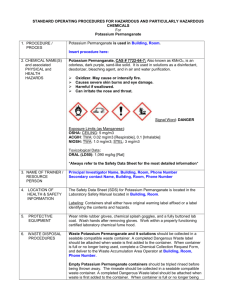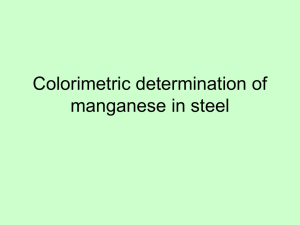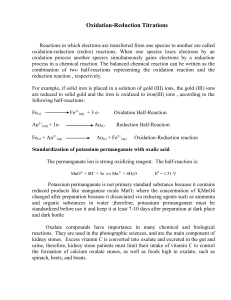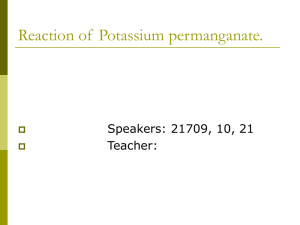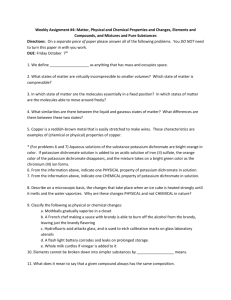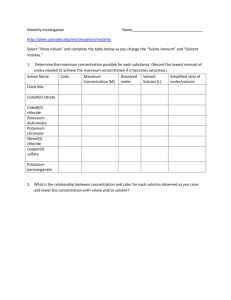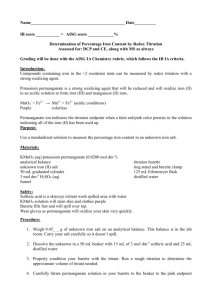Applications of Oxidation /Reduction Titration
advertisement
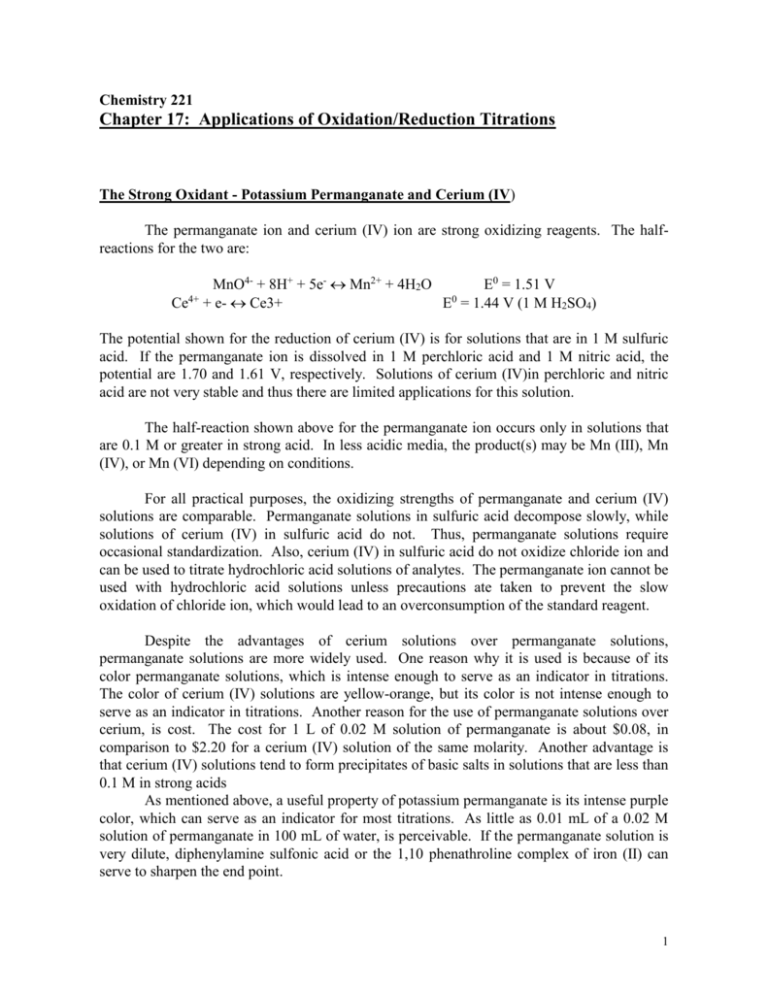
Chemistry 221 Chapter 17: Applications of Oxidation/Reduction Titrations The Strong Oxidant - Potassium Permanganate and Cerium (IV) The permanganate ion and cerium (IV) ion are strong oxidizing reagents. The halfreactions for the two are: MnO4- + 8H+ + 5e- Mn2+ + 4H2O E0 = 1.51 V Ce4+ + e- Ce3+ E0 = 1.44 V (1 M H2SO4) The potential shown for the reduction of cerium (IV) is for solutions that are in 1 M sulfuric acid. If the permanganate ion is dissolved in 1 M perchloric acid and 1 M nitric acid, the potential are 1.70 and 1.61 V, respectively. Solutions of cerium (IV)in perchloric and nitric acid are not very stable and thus there are limited applications for this solution. The half-reaction shown above for the permanganate ion occurs only in solutions that are 0.1 M or greater in strong acid. In less acidic media, the product(s) may be Mn (III), Mn (IV), or Mn (VI) depending on conditions. For all practical purposes, the oxidizing strengths of permanganate and cerium (IV) solutions are comparable. Permanganate solutions in sulfuric acid decompose slowly, while solutions of cerium (IV) in sulfuric acid do not. Thus, permanganate solutions require occasional standardization. Also, cerium (IV) in sulfuric acid do not oxidize chloride ion and can be used to titrate hydrochloric acid solutions of analytes. The permanganate ion cannot be used with hydrochloric acid solutions unless precautions ate taken to prevent the slow oxidation of chloride ion, which would lead to an overconsumption of the standard reagent. Despite the advantages of cerium solutions over permanganate solutions, permanganate solutions are more widely used. One reason why it is used is because of its color permanganate solutions, which is intense enough to serve as an indicator in titrations. The color of cerium (IV) solutions are yellow-orange, but its color is not intense enough to serve as an indicator in titrations. Another reason for the use of permanganate solutions over cerium, is cost. The cost for 1 L of 0.02 M solution of permanganate is about $0.08, in comparison to $2.20 for a cerium (IV) solution of the same molarity. Another advantage is that cerium (IV) solutions tend to form precipitates of basic salts in solutions that are less than 0.1 M in strong acids As mentioned above, a useful property of potassium permanganate is its intense purple color, which can serve as an indicator for most titrations. As little as 0.01 mL of a 0.02 M solution of permanganate in 100 mL of water, is perceivable. If the permanganate solution is very dilute, diphenylamine sulfonic acid or the 1,10 phenathroline complex of iron (II) can serve to sharpen the end point. 1 The permanganate end point is not permanent because excess permanganate ion slowly reacts with the relatively large concentration of manganese (II) ions that are present at the end point. 2MnO4- + 3Mn2+ + 2H2O 5MnO2(s) + 4H+ The equilibrium constant for this reaction if of the order 1047. This indicates that the equilibrium concentration of permanganate ion is small even in a highly acidic media. The rate at which this equilibrium is approached is slow and the end point fades only gradually over a period of about 30 seconds. The solutions of cerium (IV) as mentioned above, are yellow-orange in color, but are not intense enough to serve as an indicator for a titration. The most widely used indicator for cerium (IV) solutions is the iron (II) complex of 1,10 phenathroline or its substituted derivatives. Aqueous solutions of permanganate are not entirely stable because the permanganate ion tend to oxidize water forming manganese dioxide. - - 4 MnO4 + 2 H2O 4 MnO4 (s) + 3 O2(g) + 4 OHAlthough the equilibrium constant for this reaction indicates that the formation of manganese dioxide is favored, when properly prepared, the solution is fairly stable because the decomposition reaction is slow. The decomposition reaction is catalyzed by light, heat, acids, bases, manganese (II) and manganese dioxide. Manganese dioxide can be found in even the best grade of potassium permanganate. Removal of manganese dioxide by filtration before standardization will improve the stability of the solution. Paper cannot be used for filtering because permanganate ion reacts with it to form additional manganese dioxide. Solutions containing excess standard permanganate should never be heating because, as mentioned above, they decompose by oxidizing water. 2 Primary Standards Sodium oxalate (Na2C2O7) is widely used to standardize permanganate and cerium (IV) solutions. In acidic solutions, the oxalate ion is converted to the undissociated acid. - 2+ 2 MnO4 + 5 H2C2O4 + 6H+ 2 Mn + 10 CO2(g) + 8 H2O The same oxidation products are formed with cerium (IV). The reactions between the permanganate ion and oxalic acid is complex and proceeds slowly, unless manganese (II) is present. As the concentration of manganese (II) builds up, the reaction proceeds more and more rapidly as a result of autocatalysis. It has been observed that solutions of sodium oxalate are titrated at 60 C to 90 C, the consumption of permanganate is 0.1-0.4% less than the theoretical. This deviation is probably caused by the air-oxidation of oxalic acid. During such a titration, after the permanganate is completely consumed, the solution is heated to 60 C and titrated until a pink end point is observed for approximately 30 seconds. For most purposes, the direct titration of hot oxalic acid would provide adequate data (approximately 0.2-0.3% high). If greater accuracy is required, a direct titration of the hot solution of one portion of the primary standard can be followed by titration of two or three portions that are not heated until the end. The table below (Skoog 316), lists some of the applications of permanganate and cerium (IV) solution for the volumetric determination of inorganic species. Note though, that both reagents have also been applied to the determination of organic compounds with oxidizable functional groups. Potassium Dichromate The dichromate ion is reduced to green chromium (III) ion. Cr2O72- + 14H+ + 6e- 2Cr2+ + 7H2O E0 = 1.33 V Dichromate titrations are generally carried out in solutions that are about 1 M in hydrochloric or sulfuric acid. In these solution, the formal potential for the half-reaction is 1.0 to 1.1 V. Potassium dichromate solutions are stable indefinitely and can be boiled without decomposition. The primary-standard reagent is available commercially and at modest cost. In comparison to permanganate and cerium (IV), the disadvantages of potassium dichromate lies in its lower electrode potential and its slowness to react with certain reagents. For most purposes, reagent-grade potassium dichromate is sufficiently pure to permit the direct preparation of standard solutions. The solid is dried at 150-200 C before being weighed. The orange color of dichromate solution is not intense enough for use in end-point detection. Diphenylamine sulfonic acid is an excellent indicator for titrations with dichromate. The oxidized form of the indicator is violet, and its reduced form is essentially 3 colorless. Therefore, in the direct titration the color change observed should be from the green of chromium (III) to violet. The principle use of dichromate is for the volumetric titration of iron (II). Cr2O72- + 6Fe2+ +14H+ 2Cr2+ + 6Fe3+ + 7H2O The reaction of dichromate with iron (II) has been widely used for the indirect determination of a variety of oxidizing agents. In these applications, a measured excess of iron (II) solution is added to an acidic solution of the analyte. The excess iron (II) is then back-titrated with standard potassium dichromate. Standardization of the iron (II) solution by titration with the dichromate is performed concurrently with the analysis because solutions of iron (II) tend to be air-oxidized. This method has been applied to the determination of nitrate, chlorate, permanganate and dichromate ion as well as organic peroxides and several other oxidizing agents. Iodine Solutions of iodine are weak oxidizing agents that are used for the determination of strong reductants. I3- +2e- 3I- E0 = 1.33 V Standard iodine solutions have relatively limited applications compared with the other oxidants we have described because of the significantly lower electrode potential of the I3-/Icouple. The low potential is advantageous because it imparts a degree of selectivity that makes possible the determination of strong reducing agents in the presence of weak reducing agents. An important advantage of iodine is the availability of a sensitive and reversible indicator for the titrations. Iodine solutions though, lack stability and must be restandardized regularly. Iodine is not very soluble in water (~0.001 M). In order to obtain solutions having analytically useable concentrations, iodine is normally dissolved in moderately concentrated solutions of potassium iodide. Iodine is reasonably soluble in this media. I2(s) + I- I3- K = 7.1 X 102 Iodine dissolves slowly in solutions of potassium iodide, especially if the iodide concentration is low. To ensure complete solution, the iodine is always dissolved in a small volume of concentrated potassium iodide. Care must be taken not to dilute the concentrated solutions until the last traces of solid iodine has dissolved, otherwise the molarity of the diluted solution will gradually increase with time. This problem can be avoided by filtering the solution before standardization. 4 Air-oxidation of iodide ion can also cause changes in the molarity of an iodine solution. 4I- + O2(g) + 4H+ 2I2 + 2H2O Air-oxidation is promoted by acids, heat and light. Iodine solutions can be standardized against anhydrous sodium thiosulfate or barium thiosulfate monohydrate. OCl- + 2I- 2H+ Cl- + I2 + H2O (unmeasured excess KI) 22I2 + 2S2O3 2I- + 2S4O6 The table below summarizes the methods that use iodine as an oxidizing agent (Skoog 322). Potassium Bromate Primary-standard potassium bromate can be used directly to prepare standard solutions that are stable indefinitely. Direct titrations with potassium bromate are relatively few. Instead, potassium bromate is used as a convenient and widely used source of bromine. In this method, an unmeasured excess of potassium bromide is added to an acidic solution of the analyte. Introduction of a measured volume of standard potassium bromate results in the production of a stiochiometric quantity of bromide BrO3- + 5Br- + 6H+ 3Br2 + 3H2O This indirect generation overcomes the problems of the instability of the standard bromine solution. The primary use of standard potassium bromate is the determination of organic compounds that react with bromine. Few of these reactions proceed fast enough to permit direct titration. Instead, a measured excess of standard bromate is added to the solution that contains the sample plus as excess of potassium bromide. After acidification, the mixture is allowed to react until the presence of bromine is evident. To determine the excess bromine, an unmeasured excess of potassium iodide is introduced to convert the excess bromine to iodine: 2I- + Br2 I2 + 2BrThe liberated iodine is then titrated with standard sodium thiosulfate. For organic determinations, bromine is introduced into an organic molecule via substitution or addition. 5
